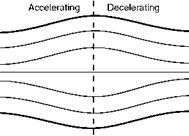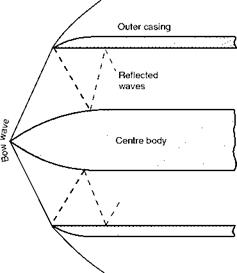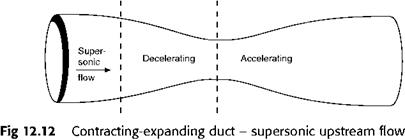Expanding-contracting duct
The fact that a venturi tube has an effect at supersonic speeds opposite to that at subsonic speeds leads one to wonder whether we could not get the venturi effect at supersonic speeds by having a duct shaped the opposite to that of a venturi tube, i. e. by first expanding and then contracting – and the answer, of course, is yes.
Figure 12.13 shows supersonic flow through an expanding-contracting duct.
|
|
 |
Fig 12.13 Supersonic flow through an expanding-contracting duct
 |
The purpose of ramjets and jet engines is to provide the thrust to propel the aeroplane or missile, and it can only do this if the velocity of outflow from the engine is greater than the velocity of the aeroplane or missile through the air. The air enters the ramjet or turbojet at the inlet where it arrives with the velocity of the aeroplane; if this is above the speed of sound we can by a clever arrangement of a centre body in the inlet (Fig. 12.14) cause shock waves to be formed here and so put up the pressure which, in the case of the turbojet, is further increased by the compressor itself. The air then speeds up in the expanding duct, and the burning of the fuel adds still further to its energy. When the gases leave the jet pipe a system of shocks and expansion wave will form in the emerging jet if the pressure is not matched to that of the atmosphere at exit, resulting in losses and consequent inefficiency.
Fig 12.14 Centre body at the inlet of a ramjet or turbine
Since the angle of the bow wave will depend on the Mach Number, the
centre body must be movable to be fully effective.
But we are not yet beaten. If we now add a divergent nozzle to the contracting duct (Fig. 12.15) we get at the throat an expansion wave which is reasonably gradual and, after it, a decrease of pressure more gradually to atmospheric, together with an increase of velocity – which is just what we wanted. It is in this form that the convergent-divergent nozzle is sometimes referred to as a de Laval nozzle after the famous turbine engineer of that name.














